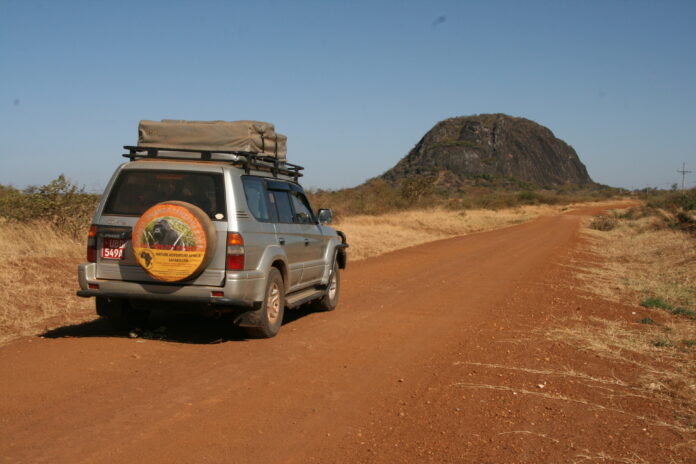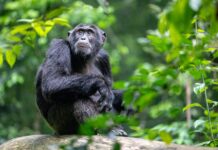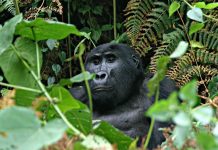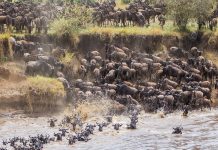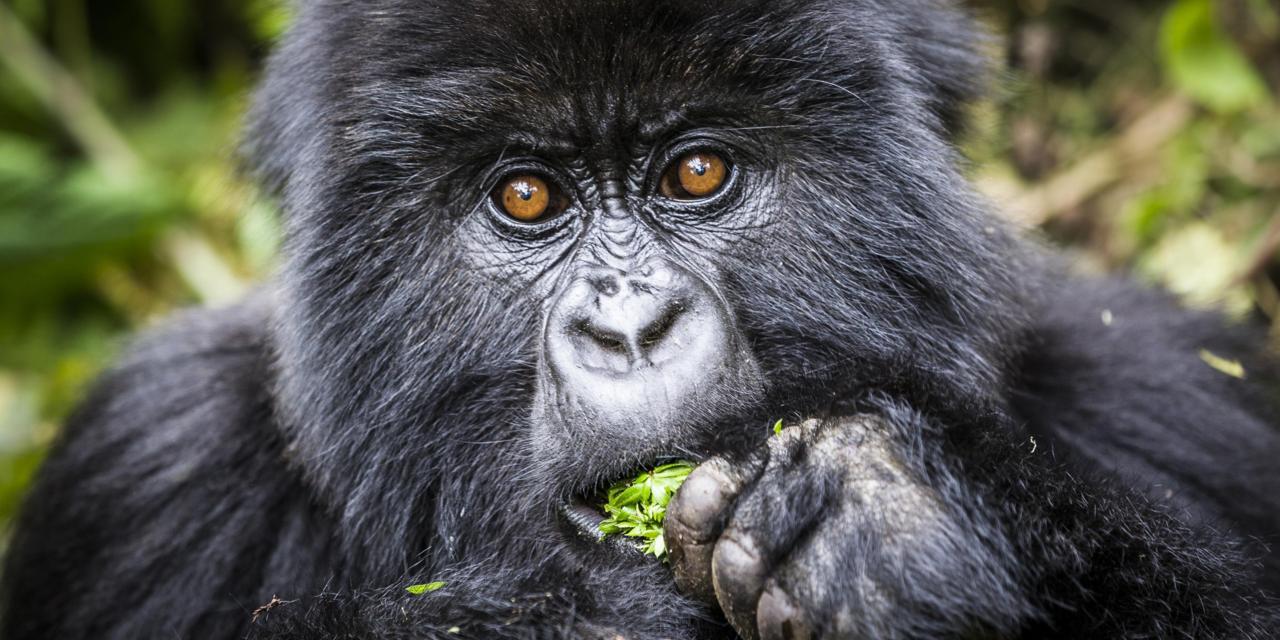Tanzania’s Serengeti National Park is selected East Africa as the over winner safari park and best for self-drive holidays in East Africa. This country offers safari experiences for visitors in East Africa. With its natural beauty and greatest concentration of game you are ever likely to see, the Serengeti is faultless as a safari destination. The vast ecosystem features rolling golden plains, complex river systems, the Big Five, and the annual wildebeest migration is the largest single movement of wildlife on earth.
No surprise, since this is one of the most incredible and, thanks to the annual crossing of the crocodile-filled Mara River that features in countless nature documentaries, best-known wildlife spectacles in the world. The Serengeti’s big cat population is second to none. There are an estimated 3,000 lions in the park, more than 10% of Africa’s entire lion population.
So many different antelopes, majestic elephants, more unusual species such as bat eared foxes and serval, and of course the big cats. You stand a good chance of seeing cheetah hunting, you can be lucky with leopards and then there are the lions.
Balloon safaris are a popular add-on to the Serengeti experience and, in one of the most exciting recent developments in the safari world, walking safaris and bush camping are now allowed here, albeit on a limited scope.
Tanzania’s Ngorongoro Crater
Ngorongoro Crater is one of the largest unbroken calderas in the world, and the view from above is one of the most stunning vistas in Africa. It’s one of the few places I’ve visited where seeing pictures or video before seeing the real things did nothing to diminish the magic of the moment. But, it’s not the scenery that makes Ngorongoro the most visited destination in Tanzania, it’s the unrivalled abundance of wildlife inside the crater; in particular predators, for which this is the highest density of any single spot in Africa.
Even more thrilling is the high likelihood of seeing black rhino. This would make for a relatively easy Big Five day if it weren’t for the fact that Ngorongoro’s leopards mostly stick to the forested fringes of the crater and are rarely seen. But besides wildlife, Ngorongoro is an excellent trekking destination and also home to over 40,000 Maasai, plus the Oldupai Gorge, where many important fossils of early human ancestors have been found, cuts across the west.
Tanzania’s Lake Manyara National Park
Lake Manyara National Park is one of the most scenic parks in Tanzania and good for self-drive safaris. Patches of yellow fever trees are dotted around the grassy lake shores and the rift valley wall is a prominent feature throughout the park.
Despite this, the park is notable for its great diversity of habitats, and for its remarkably high biomass density of large animals. Hippos, elephants, zebras, giraffes and buffaloes are all frequently spotted, and with luck, you may see one of the tree-climbing lions for which Manyara is famed. Manyara is also one of the few parks where you can do night drives. Among the things I like best about the greater Manyara area are the wonderful views down over the lake from the top of the escarpment.
Kenya’s Masai Mara National Park
Legendary Masai Mara is the most visited wildlife reserve in Kenya and it’s easy to see why for guided and self-drive tours. These 1,800 square km parks support a huge and diverse animal population and is one of the only places in the world where it is still possible to see vast herds of grazing animals. Attracted by the abundant wildebeest, antelope, buffalo and zebra are the predators.
There are more lions here than anywhere else in the country, and leopard, cheetah, jackal and hyena also wander the grasslands. Far reaching views across open plains ensure that wildlife is almost never out of sight and it’s not unusual to see a dozen different species at the same time – all good news for big five enthusiasts. It also has some highly alluring and charismatic places to stay, perfect for a classic guided or self-drive safari. While it’s rightly popular, it’s never quite as crowded as the more accessible parks.
Kenya’s Amboseli National Park
Self- driving in Amboseli hugs the Tanzanian border and makes for one of Kenya’s most dramatic photo opportunities, herds of elephant lumbering past with Mount Kilimanjaro as a backdrop. The park is famous for them and groups of up to 100 are not uncommon. Amboseli is the park where Kenya’s biggest tuskers roam against the stunning backdrop of Kilimanjaro the world’s highest freestanding mountain. At its foot lie lush green swamps a dream of water in a thirsty land. Fed by the melt waters of Kilimanjaro’s glaciers, they are vital to the park’s well-being.
Lions, too, are commonly sighted, often within a short distance of the lodges in the centre of the park, as are giraffe, zebra and various antelope species; the open plains are classic cheetah country. Amboseli hosts astonishingly rich birdlife with 370 recorded species, almost one for every square metres of the park.
Uganda’s Kidepo Valley National Park
Blissfully remote and stunningly gorgeous park. Kidepo is by far the most difficult to reach but absolutely worth the time and effort to self- driving to get there. Kidepo is Uganda’s slice of quintessential East African savanna. The Narus Valley teems with wildlife in the dry season and it’s not uncommon to see buffalo gatherings numbering in their thousands and elephants in their hundreds.
This is also Uganda’s only park where cheetah can be seen. I love this place: it’s a true African wilderness of extreme beauty with large concentrations of wildlife still enduring. It is also the definition of remote; and the reason there are so few tourists here and suitable to visit with 4×4 rooftop tent vehicle. Other wildlife associated with the Narus Valley includes Rothschild’s giraffe, Burchell’s zebra, Bohor reed buck and oribi, while characteristic birds with a very limited distribution elsewhere in East Africa are Clapperton’s francolin and rose-ringed parakeet.
Uganda’s Murchison Falls National Park
Murchison Falls National Park is a nice destination for a road trip. Murchison Falls is where the Nile tumbles down the Rift Valley escarpment. Although the wildlife viewing is excellent in this park, it is the scenery that really gets to me: the rolling grassy hills studded with borassus palms teeming with plains animals, the papyrus swamps home to the sought after shoe bill stork and forests inhabited by chimpanzees.
But, the main feature in the park is the Victoria Nile. A highlight to any visit is a boat trip up the Nile to one of the most spectacular sights of water pushing through a cleft in the escarpment: Murchison Falls. Gliding on this mighty river is an unforgettable experience: hippos snorting everywhere, elephants playing in the water and lots of water birds along the shore. The afternoon boat trip is great for spotting animals coming to drink. Once we even spotted a leopard from the boat.
The main antelope in the park is the Uganda kob and big herds of them inhabit the grassy plains north of the river. If you watch these antelopes carefully, you won’t have any problems spotting lions. The Kob’s alarm signal, a high-pitched whistle is unmissable. Then it’s just a matter of following their gaze.
Uganda’s Bwindi Impenetrable National Park
Staring at a gorilla in the eye is undoubtedly a magical wildlife encounter. Bwindi Forest is an outstandingly beautiful place; a magnificent green swathe of tangled forest that clings to the steep ridges of the Western Rift Valley. But the trek to find the gorillas should never be underestimated; it’s a tough scramble up and down wet and slippery hills through the dense undergrowth. But that all adds to the achievement, and nothing can beat the excitement when your tracker halts abruptly in front of you, hesitantly sniffs and listens to the crisp air, motions for you to sink to the ground, and then slowly point.
